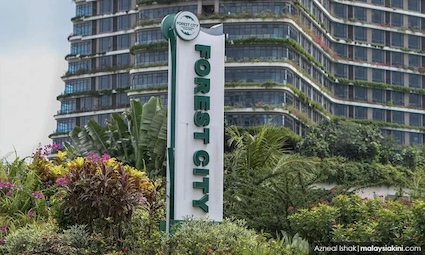Can Forest City be country’s economic lifeboat?

By Lim Teck Ghee, Murray Hunter & Carolyn Khor
As the nation battles insufficient tax revenue, growing government debt, and the inability of government-linked companies (GLCs) to catalyse the economy, young Malaysians are increasingly unable to find rewarding employment and losing hope that their future in Malaysia will be promising and secure.
The writing was on the wall from a long time ago with worker migration to Singapore and elsewhere increasing since the launch of the New Economic Policy.
According to former human resources minister V Sivakumar, some 1.13 million out of 1.86 million Malaysians who migrated overseas resided in Singapore.
Two studies conducted in 2022 found that 39 percent of the diaspora working in Singapore are skilled workers and 35 percent are semi-skilled, while in Brunei, 68 percent of the working diaspora are skilled workers and 24.1 percent are semi-skilled.
Our national brain-drain rate of 5.5 percent of the population officially revealed recently compares badly with the 3.3 percent for the world. It may be an underestimate and may also conceal the disconcerting fact that a disproportionate number consists of some of our brightest talents and entrepreneurs.
Stemming outmigration and providing a sustainable and game-changing stimulus to the economy is among the biggest, if not the biggest challenge for the nation.
Background
Can Forest City and the South Johor Special Economic Zone emulate the Shenzhen model which propelled the earlier sleepy Pearl River delta region into a powerhouse of global economic development?
Forest City in Iskandar Puteri, Johor was initially planned as an integrated residential development. Commenced in 2006 by a consortium of mainland Chinese real estate developers, this was touted as an adjunct to the Belt and Road Initiative (BRI).
Its developer, Country Garden Pacificview Sdn Bhd, is a joint venture between Country Garden Group and Esplanade Danga 88 Sdn Bhd (EDSB), a Malaysian government-backed company. Country Garden, a company on the Hong Kong Stock Exchange’s main board, is listed among the Fortune Global 500 and is one of the top three developers in China.
The grand vision of the project was to create a luxury township enclave for well-to-do citizens from China. It was envisioned that the township would attract Chinese wealth and investment and build a new modern city, built on four man-made islands on the Straits of Johor adjacent to Singapore.
The first island was planned as the high-tech industrial zone, followed by the second one, as the central business district and tourism zone. The third island was supposed to be the financial and economic districts, while the fourth island was intended as a conference and forum zone. The entire development was supposed to be completed by 2035.
However, the project was hit in 2018 by then-prime minister Dr Mahathir Mohamad, who declared foreigners would not be granted visas to live in Forest City. Further, currency controls introduced by President Xi Jinping in 2019 drastically restricted potential customers and the onslaught of the Covid-19 pandemic dealt a body blow to the project.
Today, the Forest City project, dubbed the “city in the sea”, is a ghost town and a lost opportunity for the Johor and national economy. Forest City’s potential as a city to take the overflow from Singapore, similar to what Shenzhen did for Hong Kong, remains unfulfilled.
What will it take to revitalise Forest City so it can live up to its promise as a game changer in the national economy?
A reconfiguration and revision for Forest City requires the setting up of parameters to revitalise the project. The challenges ahead can be very clearly seen in the Swot analysis below:

